The Christmas Tree Cluster is a young open cluster located in the constellation Monoceros. It is part of the star-forming region NGC 2264, which also contains the Cone Nebula, the Fox Fur Nebula, and the Snowflake Cluster.
The Christmas Tree Cluster lies at an approximate distance of 2,350 light-years and stretches about 30 light-years across. It is a member of the Monoceros OB1 association, a loose association of very young stars located in the Orion Arm of the Milky Way.
The stars in the cluster formed within the emission nebula NGC 2264. They are still heavily obscured by the thick dust clouds that keep producing new stars. The ultraviolet light of the luminous young stars ionizes the surrounding clouds and makes them glow red in long-exposure images.
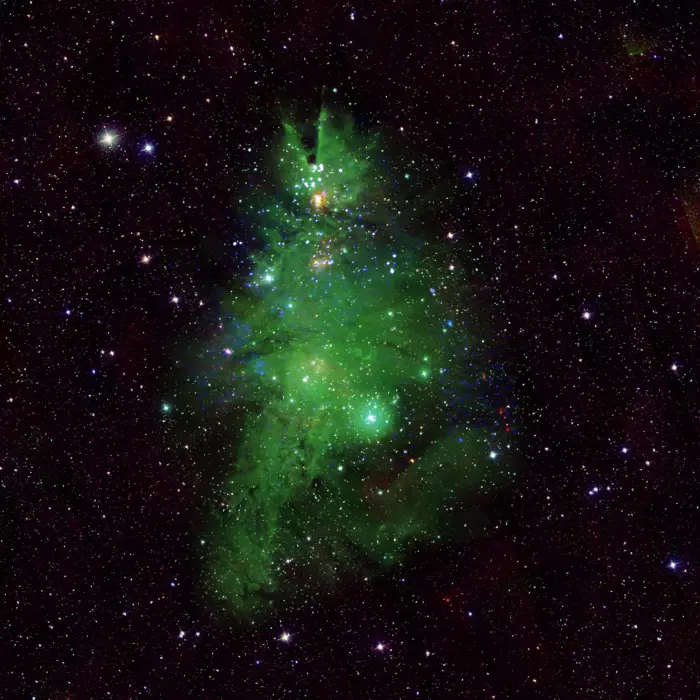
Composite image of the Christmas Tree Cluster, image credit – X-ray: NASA/CXC/SAO; Optical: T.A. Rector (NRAO/AUI/NSF and NOIRLab/NSF/AURA) and B.A. Wolpa (NOIRLab/NSF/AURA); Infrared: NASA/NSF/IPAC/CalTech/Univ. of Massachusetts; Image Processing: NASA/CXC/SAO/L. Frattare & J. Major (CC BY 4.0)
In December 2023, NASA released a composite image of the cluster that highlighted its resemblance to a Christmas tree. In the animated version of the image, the young stars that emit X-rays, captured by NASA’s Chandra X-ray Observatory, appear as blinking blue and white lights.
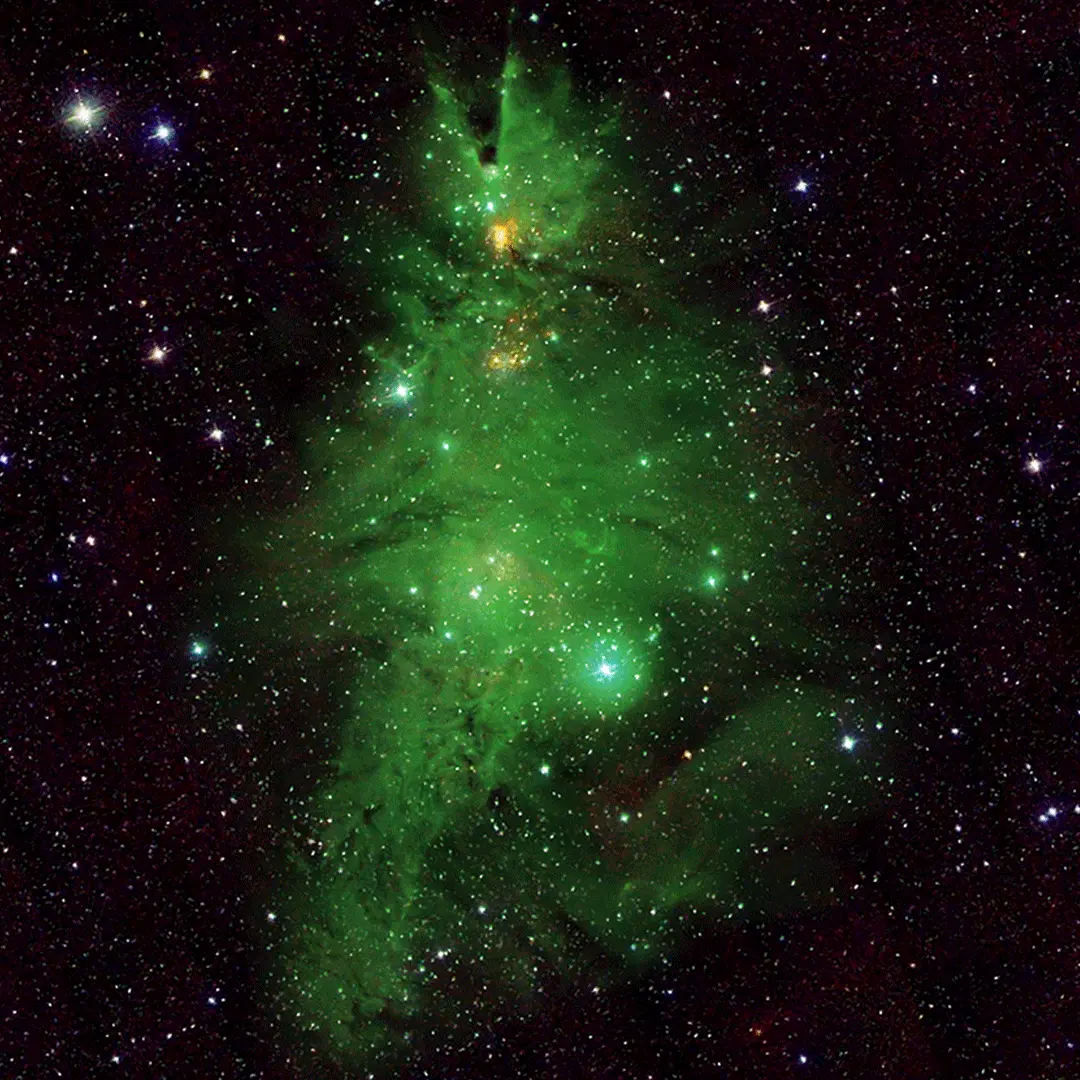
Animated image of the Christmas Tree Cluster, credit – X-ray: NASA/CXC/SAO; Optical: T.A. Rector (NRAO/AUI/NSF and NOIRLab/NSF/AURA) and B.A. Wolpa (NOIRLab/NSF/AURA); Infrared: NASA/NSF/IPAC/CalTech/Univ. of Massachusetts; Image Processing: NASA/CXC/SAO/L. Frattare & J. Major (CC BY 4.0)
The gas in the surrounding nebula appears green, evoking the pine needles of a Christmas tree. The optical data was taken from the National Science Foundation’s WIYN 0.9-meter telescope at the Kitt Peak National Observatory in Arizona. The white stars in the foreground and background of the cluster were captured in the Two Micron All Sky Survey (2MASS).
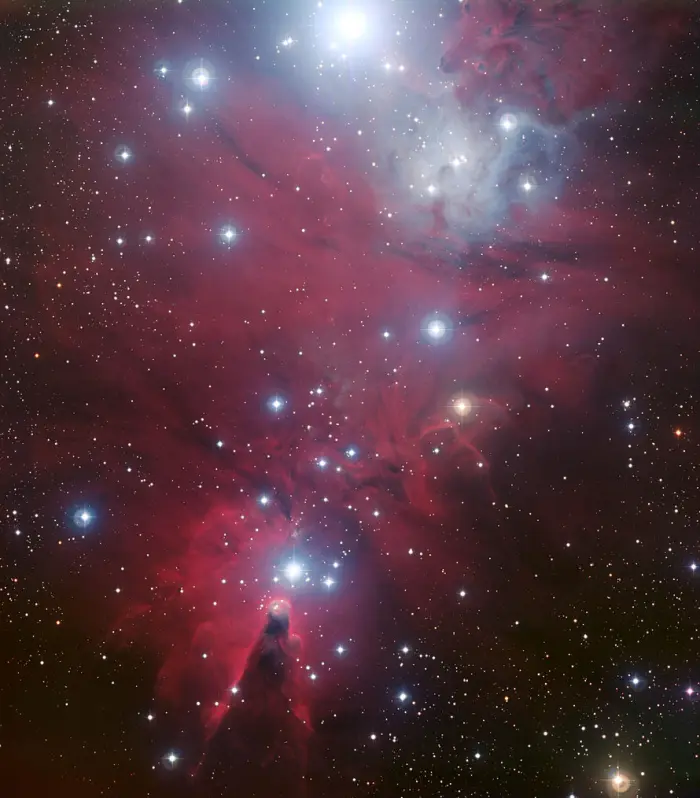
This colour image of the region known as NGC 2264 — an area of sky that includes the sparkling blue baubles of the Christmas Tree star cluster — was created from data taken through four different filters (B, V, R and H-alpha) with the Wide Field Imager at ESO’s La Silla Observatory, 2400 m high in the Atacama Desert of Chile in the foothills of the Andes. The image shows a region of space about 30 light-years across. Image credit: ESO (CC BY 4.0)
The Christmas Tree Cluster was named for its triangular shape, formed by a cluster of very young stars, that looks like a tree in visible light. It is located in the northern part of NGC 2264, just above the Cone Nebula.
The seventh magnitude member HD 47887 sits just above the tip of the Cone, while the bright variable star S Monocerotis (15 Monocerotis) lies slightly to the north and marks the trunk of the Christmas tree. The apex of the tree is located next to the Cone Nebula.
HD 47887 is a young stellar object with the spectrum of a luminous blue giant (B2III). The star has an estimated temperature of 19,918.2 K based on the data obtained from the Gaia Data Release 3 (GDR3). It lies 2,504 light-years (767.9 parsecs) away.
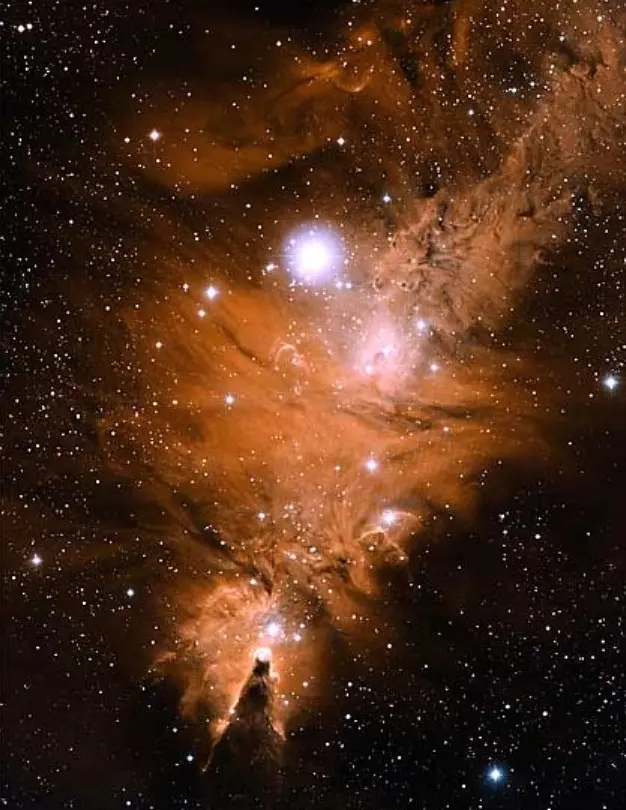
The Christmas Tree Cluster (NGC 2264), image credit: NASA/JPL-Caltech/P.S. Teixeira & C.J. Lada (CfA)/E.T. Young (U. Arizona)
S Monocerotis, which lies at the base of the cluster, is the brightest star in NGC 2264. It has an apparent magnitude of 4.66 and is visible to the unaided eye on a clear, dark night. The star is classified as an irregular variable. Its brightness varies from magnitude 4.62 to 4.68.
S Monocerotis is in fact a multiple-star system composed of a spectroscopic binary pair, S Monocerotis A, and a hot blue B-type main sequence star, S Monocerotis B.
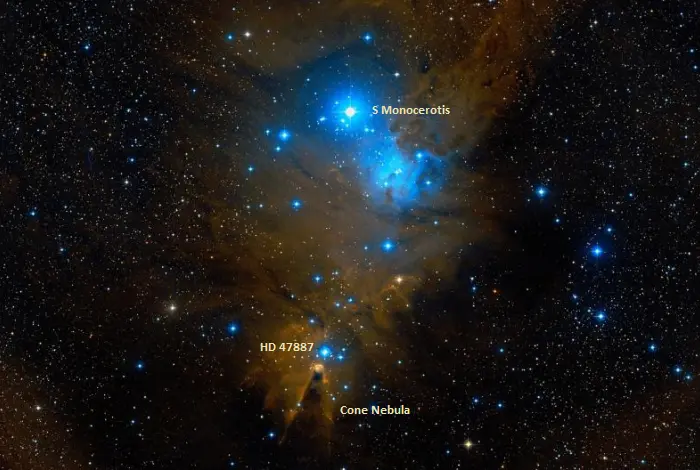
The brightest stars in the Christmas Tree Cluster, image: Wikisky
The binary star S Monocerotis A consists of two massive, luminous O-type main sequence stars with masses 29.1 and 21.3 times that of the Sun. The more massive component is 214,000 times more luminous than the Sun and spins at 120 km/s. The two stars have an orbital period of about 108 years and are separated by 112.5 milliarcseconds. They lie 2,348 light-years away.
The B-type companion has a mass of 7.8 solar masses and is separated by 7.3 arcseconds from the main pair. It lies approximately 2,300 light-years away.
There is a fourth component, an 11th-magnitude B8V star located a little closer to us, at a distance of about 2,110 light-years.
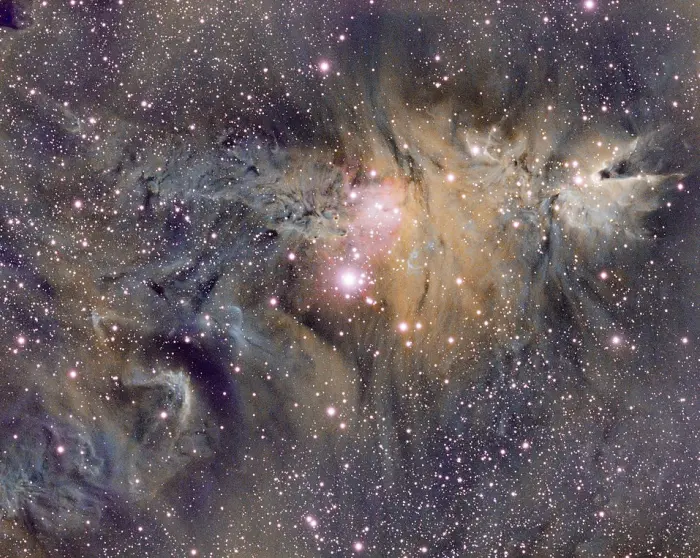
The Christmas Tree Cluster and the Cone Nebula, image credit: Vladimir Goman (CC BY 4.0)
The stars in the Christmas Tree Cluster formed very recently from the surrounding molecular cloud. The cluster contains more than 600 members that are 1 to 4 million years old, including several dozen OB stars and more than 400 lower mass members.
The Christmas Tree Cluster was discovered by the German-born British astronomer William Herschel on January 18, 1784. Herschel catalogued the cluster as H VIII.5. He did not discover the surrounding nebulosity until December 26, 1785, when he noticed “faint nebulosity near the cluster’s brightest star.”
The Christmas Tree Cluster is catalogued as Collinder 112 in Swedish astronomer Per Collinder’s 1931 catalogue of open clusters.
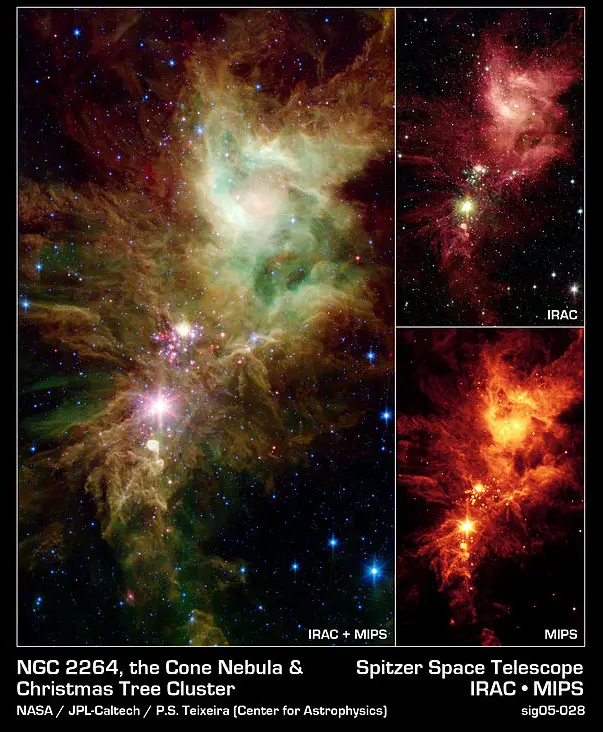
Newborn stars, hidden behind thick dust, are revealed in this image of a section of the Christmas Tree Cluster from NASA’s Spitzer Space Telescope, created in joint effort between Spitzer’s Infrared Array Camera (IRAC) and Multiband Imaging Photometer (MIPS) instruments.
The newly revealed infant stars appear as pink and red specks toward the center of the combined IRAC-MIPS image (left panel). The stars appear to have formed in regularly spaced intervals along linear structures in a configuration that resembles the spokes of a wheel or the pattern of a snowflake. Hence, astronomers have nicknamed this the “Snowflake Cluster.” Star-forming clouds like this one are dynamic and evolving structures. Since the stars trace the straight line pattern of spokes of a wheel, scientists believe that these are newborn stars, or “protostars.” At a mere 100,000 years old, these infant structures have yet to “crawl” away from their location of birth. Over time, the natural drifting motions of each star will break this order, and the snowflake design will be no more. While most of the visible-light stars that give the Christmas Tree Cluster its name and triangular shape do not shine brightly in Spitzer’s infrared eyes, all of the stars forming from this dusty cloud are considered part of the cluster. Image credit: NASA/JPL-Caltech/P.S. Teixeira (Center for Astrophysics)
NGC 2264 is not to be confused with the Christmas Tree Galaxy Cluster (MACS0416), a distant cluster of galaxies discovered in images taken by the Hubble Space Telescope (HST) during the Southern Massive Cluster Survey (SMACS) and captured by the James Webb Space Telescope (JWST) in 2023.
Location
The Christmas Tree Cluster is located in the faint constellation Monoceros (the Unicorn), which lies in an area full of first- and second-magnitude stars. Most of the constellation lies within the Winter Triangle, formed by Sirius, Procyon, and Betelgeuse, but the cluster appears just outside it.
The Christmas Tree Cluster can be found using the brightest stars of Orion and Canis Minor. It lies just north of the midpoint of the imaginary line connecting Betelgeuse at the shoulder of Orion and Procyon, the brightest star in Canis Minor. A line extended from Bellatrix to Betelgeuse in the direction of Alzirr in Gemini leads to the cluster.
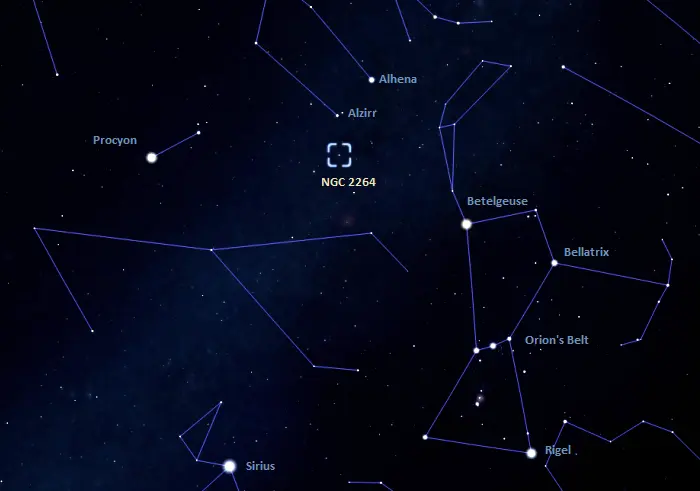
The location of the Christmas Tree Cluster, image: Stellarium
The Christmas Tree Cluster is visible to the unaided eye in good conditions and appears quite striking in binoculars. The Christmas tree shape can be seen in small telescopes at low power.
Several other notable deep sky objects appear in the same area of the sky. Hubble’s Variable Nebula (NGC 2261) appears southwest of the cluster and Dreyer’s Nebula (IC 2169, IC 447) lies to the west. Hubble’s Variable Nebula is illuminated by the variable star R Monocerotis and has an apparent magnitude of 9.0. Dreyer’s Nebula is a relatively bright reflection nebula about 25 arcminutes across.
The fainter reflection nebulae NGC 2247 and NGC 2245 appear just northeast of Dreyer’s Nebula.
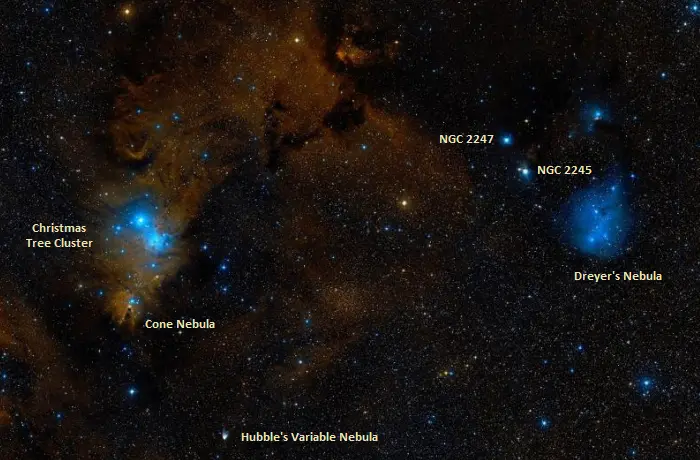
The Cone Nebula, the Christmas Tree Cluster, Hubble’s Variable Nebula and Dreyer’s Nebula, image: Wikisky
The brighter Rosette Nebula, a large emission nebula associated with the Satellite Cluster (NCGC 2244), lies south of the line connecting Betelgeuse and Procyon. It appears south and a little west of NGC 2264.
The best time of the year to observe the Christmas Tree Cluster and other deep sky objects in Monoceros is during the month of February, when the constellation is high above the horizon in the evening. Monoceros is one of the 15 equatorial constellations and can be seen from any location on Earth for at least part of the year.
Christmas Tree Cluster
| Constellation | Monoceros |
| Right ascension | 6h 40m 52.1s |
| Declination | +9° 52′ 37′′ |
| Apparent magnitude | 3.9 |
| Apparent size | 20 arcminutes |
| Distance | 2350 ± 52 light-years (719 ± 16 parsecs) |
| Names and designations | NGC 2264, Collinder 112, LBN 911, SH 2-273, OCl 495.0, C 0638+099, LBN 202.92+02.18, LBN 911, CCABS 52, OCISM 108, MWSC 0954, Sh2-273, MWSC 0954 |